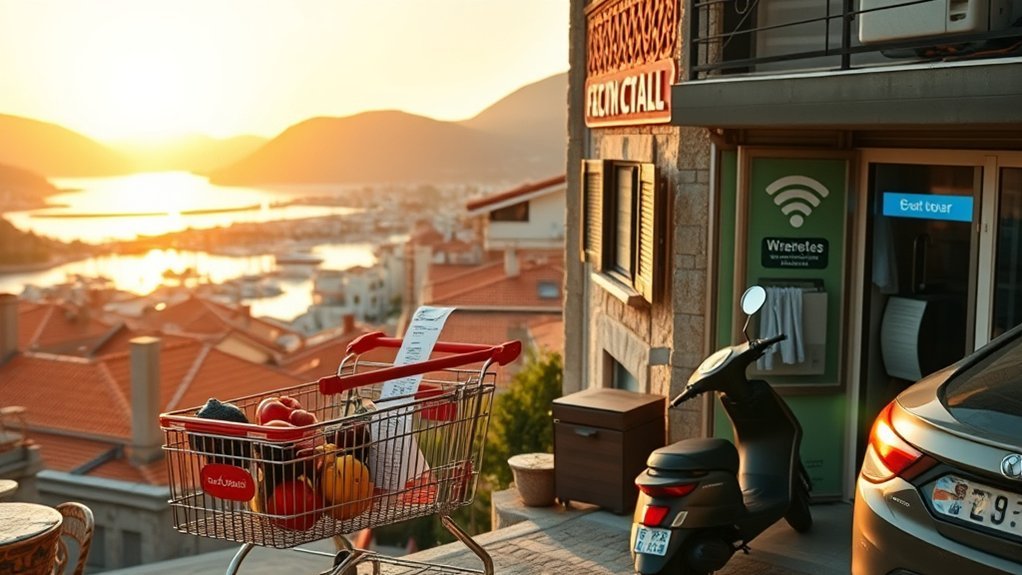You can live modestly in Montenegro on about €700–€900 a month as a single person, while a family of four typically needs €2,000–€2,800. Expect one-bedroom rents €350–€700 depending on coast vs inland, utilities €50–€100, groceries €180–€280 per person, and bus passes under €30. Eating out and private healthcare raise costs, while driving adds fuel at €1.50–€1.80/L. Keep reading for detailed city, housing and saving breakdowns.
Monthly Living Costs and Budget Examples for 2025
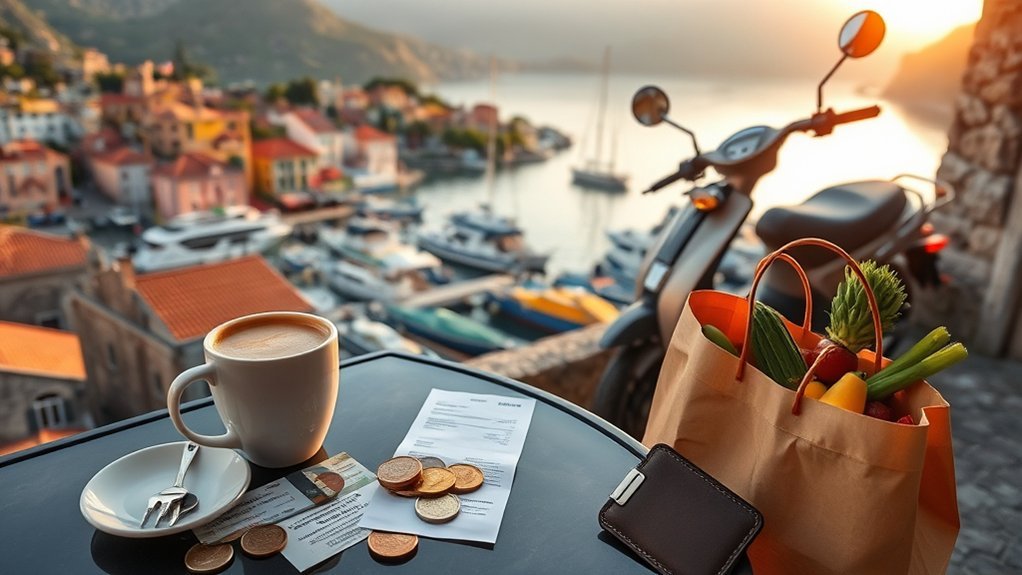
If you’re planning a move to Montenegro in 2025, expect average monthly costs of about €700–€900 for a single person and €2,000–€2,800 for a family of four, with rent, groceries, and transport forming the largest shares of those budgets.
You’ll use these figures to build a lean, liberating budget: estimated monthly costs break down roughly into rental prices (biggest variable), groceries (~€180–€280 for one), and transport (single bus €0.80–€1.50; monthly pass €20–€30).
In Podgorica, one-bed rental prices run €350–€550; coastal averages hit €400–€700, so adjust your allocation accordingly.
Staple items are cheap—milk €1.00–€1.20, bread €0.80–€1.20—letting you stretch living costs further.
Compared to the U.S., Montenegro is about 45.4% cheaper, so you can redirect savings to experiences, savings, or entrepreneurship.
Use these data-driven budget examples to claim financial freedom while keeping monthly costs predictable and controllable.
Housing and Real Estate: Rent, Purchase, and Utilities
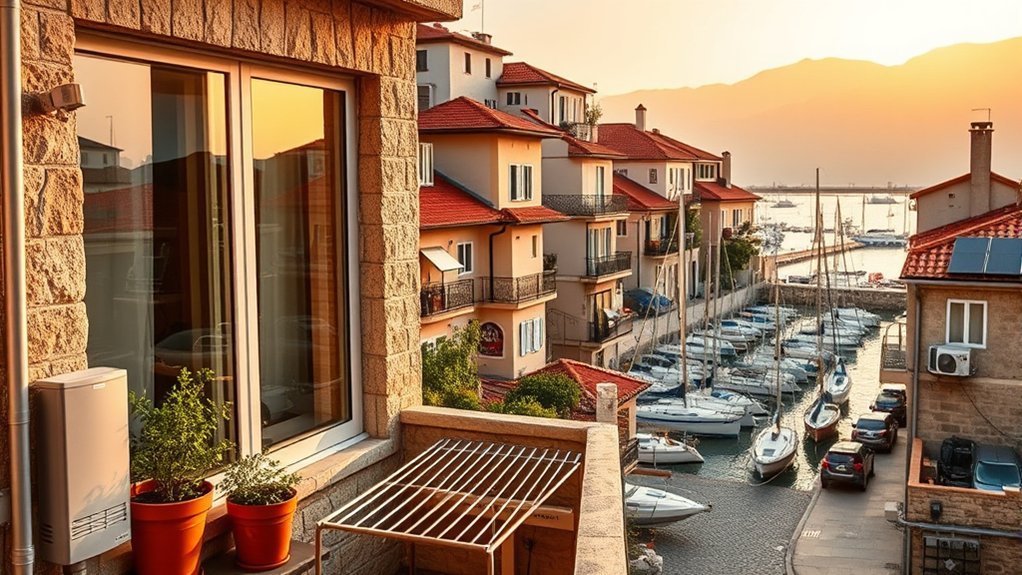
Several clear cost patterns will shape your housing budget in Montenegro: one-bedroom rentals run about €350–€550 in Podgorica and €400–€700 along the coast, studios roughly €350–€550, and two-bedrooms €450–€650, with luxury furnished units exceeding €1,500 in prime locations.
Expect one-bed rents €350–€700 (city vs. coast), studios €350–€550, two-beds €450–€650; luxury tops €1,500+.
You’ll use these ranges to plan monthly expenses tightly: base rent dominates, so prioritize location versus size. Utilities typically add €50–€100 monthly depending on heating needs and apartment size; factor seasonal spikes into your cash flow.
If you’re buying, expect average real estate prices near €1,844 per square meter, a metric that signals rising asset values and impacts long-term affordability.
For budget freedom, compare renting short-term while scouting neighborhoods to buy. Track housing, rent, utilities, and purchase costs in a simple spreadsheet to model scenarios (renting vs buying) over 3–5 years. That discipline helps you choose the path that maximizes mobility and financial liberation without sacrificing stability.
Food, Dining Out, and Everyday Essentials

Expect to budget roughly €180–€280 monthly for groceries as a single person (€400–€700 for a family), with staples like milk at €1.00–€1.20/L, bread €0.80–€1.20/loaf, and eggs €2.00–€2.50/dozen; dining out stays affordable—cheap meals run €7–€12, mid-range dinners for two average about €40, and large beers cost €2–€3—so mix home cooking with occasional restaurant lunches to keep monthly food costs predictable.
You can optimize spending by buying local produce, shopping weekly markets, and choosing store brands for pantry staples. Plan meals around seasonal items to stretch your grocery budget while supporting local suppliers.
For social freedom, factor in several restaurant meals monthly; affordable lunch menus and beer prices make casual outings sustainable. Everyday essentials like toiletries and cleaning supplies are reasonably priced if you buy in multipacks or discount stores.
Track receipts for a month to set a realistic monthly target, then adjust between groceries and dining out to align your spending with a liberated lifestyle.
Transport, Healthcare, and Other Regular Expenses
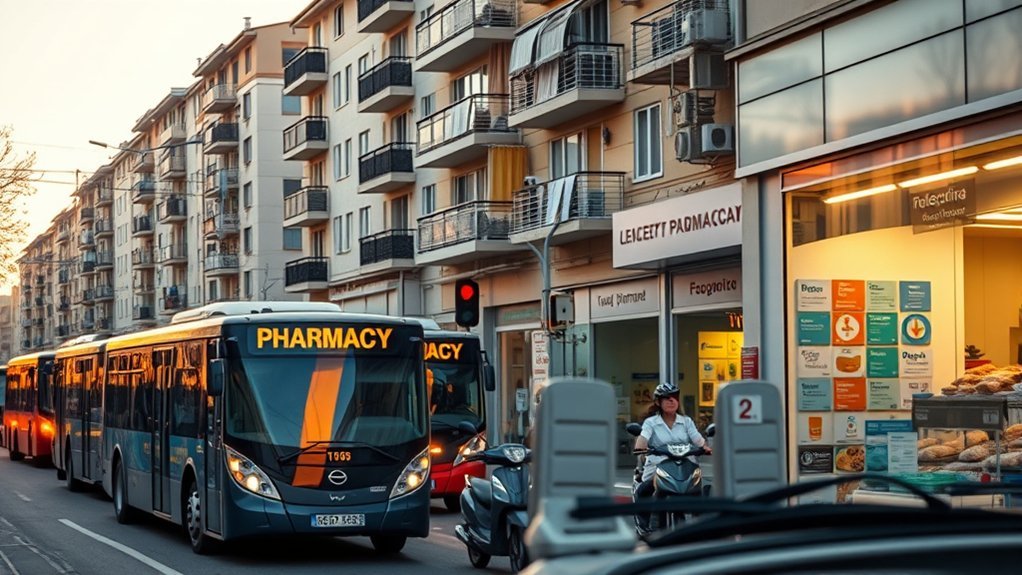
You’ll find public transport in Montenegro is inexpensive — single bus tickets run about €0.80–€1.50 and monthly passes are typically under €30, while inter-city trips like Podgorica–Budva cost €5–€7.
Healthcare is generally cheaper than in Western countries, with modest fees at public facilities though private care and insurance raise costs.
If you drive, budget for fuel at €1.50–€1.80 per liter plus maintenance and potential insurance to compare against public-transport savings.
Public Transport Costs
1 clear way to keep monthly transport costs low in Montenegro is to rely on public transit: single urban bus fares run about €0.80–€1.50 and monthly passes cost €20–€30, while inter-city routes like Podgorica–Budva are roughly €5–€7.
You’ll find public transport costs consistently affordable, letting you prioritize freedom over fixed car expenses. Buy a monthly public transport pass if you commute—€20–€30 usually beats daily fares.
For occasional regional trips, an inter-city bus fare at €5–€7 keeps travel cheap. If you’re weighing car ownership, factor fuel costs of €1.50–€1.80 per liter plus maintenance; that quickly raises your baseline spending.
Healthcare and Insurance
Healthcare costs in Montenegro are generally lower than in Western countries, with modest public-consultation fees but potentially significant out-of-pocket medicine costs that make extensive health insurance a smart budget choice.
You’ll find a mixed healthcare system shifting toward full tax-funded coverage, yet many use private clinics for faster access. Track typical consultation and medicine expenses so you can compare them to premiums for thorough health insurance—often the best hedge against unpredictable outpatient costs.
Emergency services exist, but response times vary; register with local providers and learn protocols to reduce delays.
Factor in monthly public transportation costs (€20–€30) or single-ticket fares (€0.80–€1.50) when estimating access expenses. Budget for insurance, meds, and transit to protect your freedom to move and heal.
Car Ownership Expenses
Moving from medical bills to everyday mobility, owning a car in Montenegro adds steady costs that will shape your monthly budget.
You’ll factor in car ownership expenses like fuel costs (€1.50–€1.80/L), routine maintenance costs and occasional repairs, plus parking and tolls that spike in urban centers.
If you prefer freedom without a car, public transportation is cheaper: single urban tickets €0.80–€1.50, monthly passes €20–€30.
Balance that against healthcare costs: national care is cheaper than in Western countries, but out-of-pocket medicine costs mean you should keep insurance in your calculations as part of transport-related budgeting.
Build monthly scenarios (car vs. transit) to free your finances and choose the mobility that fits your independence goals.
Where to Live: Best Cities and Regional Price Differences
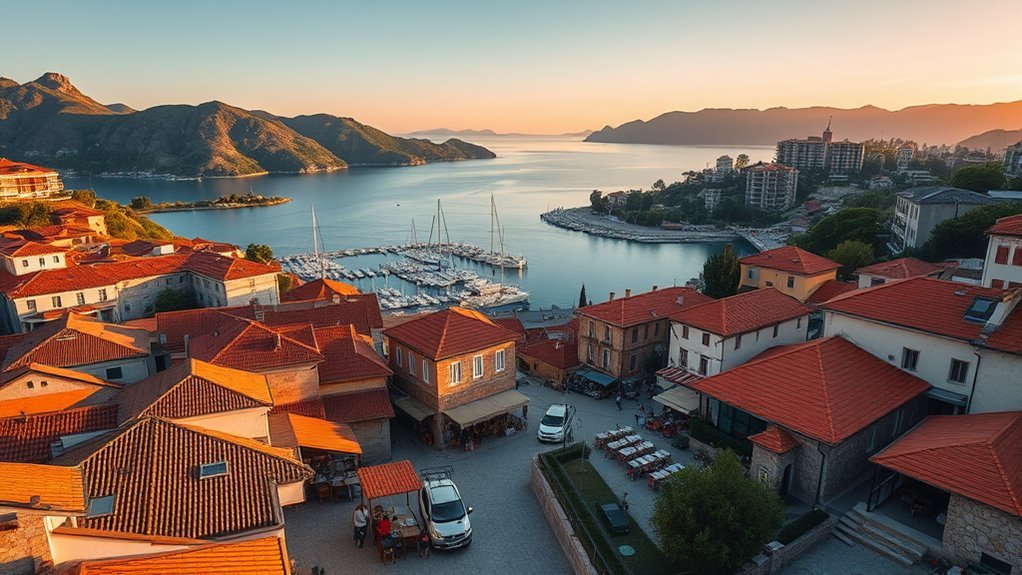
While coastal towns like Budva and Kotor draw most expats with tourism and scenery, you’ll save money and find steadier year‑round rentals in Podgorica.
One‑bedroom city‑center flats typically run €350–€550 versus €400–€700 on the coast; utilities add about €50–€100 monthly depending on size and heating. Bus passes stay under €20, and meals average €10 in local restaurants (though tourist hubs can push food prices higher).
One‑bedroom city flats: €350–€550 inland, €400–€700 on the coast; utilities €50–€100; cheap buses and €10 meals.
When choosing where to live, compare living priorities: lifestyle vs. lower rent. For a budget-focused cost of living plan, Podgorica and inland towns rank highest for value.
Coastal cities in Montenegro offer lifestyle perks but higher seasonal expenses and rental volatility. Smaller northern towns are quieter and often more affordable in Montenegro, with modest markets and lower day‑to‑day costs.
Factor in transportation time, utility needs, and how much tourist premium you’ll tolerate. Pick a city in Montenegro that aligns with your desire for freedom: lower fixed expenses in Montenegro give you flexibility to work, travel, or save.
Money-Saving Tips and Budgeting Strategies
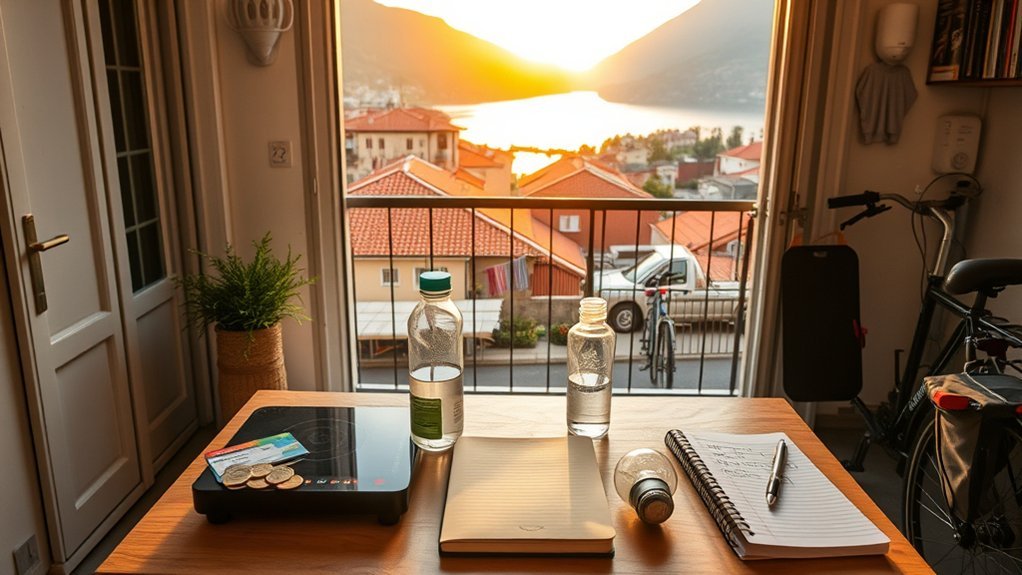
To cut monthly expenses, cook at home — groceries typically cost €180–€280 for a single person versus frequent restaurant meals at €7–€12 each.
Use public transport instead of a car; single tickets are €0.80–€1.50 and monthly passes run about €20–€30.
Combining home cooking with bus passes can shave hundreds off your monthly budget.
Cook at Home More
If you cook more at home, you can cut grocery and dining costs substantially—single people typically spend €180–€280 monthly on groceries and families €400–€700, while eating out at inexpensive restaurants costs an extra €7–€12 per meal.
Shift Cost focus to cooking at home: plan meals to lower your monthly grocery expenses and track savings versus dining out. Buy staples in bulk—milk €1.00–€1.20/l, eggs €2.00–€2.50/dozen—and prioritize local markets where 1 kg tomatoes runs about €2.57.
You’ll save per meal and reclaim financial freedom by reducing impulse spending. Measure cost per serving, batch-cook, and freeze portions.
Small systematic changes compound quickly, freeing both money and time for choices that align with your liberated lifestyle.
Use Public Transport
Because public transport fares in Montenegro are low and predictable, you can cut commuting costs dramatically by swapping car trips for buses or trams.
A single urban bus ticket costs €0.80–€1.50, so short daily rides stay cheap; if you commute frequently, a monthly public transportation pass (€20–€30) reduces per-trip costs and simplifies budgeting.
Inter-city fares, like Podgorica–Budva (€5–€7), make occasional longer trips budget-friendly without car expenses.
Choosing buses and trams also removes fuel outlays (€1.50–€1.80/L) and maintenance from your monthly expenses, freeing income for goals that matter.
Track your weekly rides, compare ticket versus pass breakeven points, and commit to public transportation when it lowers total costs—liberate your budget and cut fixed commuting burdens.
Frequently Asked Questions
Can Americans Move to Montenegro?
Yes — you can. Boldly build a better base: Visa requirements exist, but residency’s reachable; weigh cost of living, job opportunities, cultural differences, language barriers; budget, prove income, secure insurance, learn basics for liberated living.
Is Montenegro Expensive to Live In?
Not overly; Montenegro’s cost comparison shows lower living expenses than many Western countries. You’ll weigh quality of life against local salaries, use budgeting tips, track rent, food, transport, and optimize spending for freedom.
How Much Money Do You Need to Retire in Montenegro?
Picture a sturdy sailboat: you’ll need about €700–€900 monthly solo, €2,000–€2,800 for a family, factoring retirement benefits, cost of healthcare, lifestyle expectations, local taxes, and visa requirements to secure liberated living.
How Much Is Rent in Montenegro?
Average rent in Montenegro ranges €350–€700 monthly; you’ll use renting tips to favor popular locations, do cost comparison across cities, and scrutinize lease agreements to protect savings and secure affordable, liberating long-term housing choices.
Conclusion
You can live comfortably in Montenegro on roughly €700–€1,200 per month depending on city and lifestyle — in Podgorica and coastal hotspots expect the higher end. That single statistic matters: average rent for a one‑bed in the capital is about €350/month in 2025, cutting your biggest expense dramatically compared with Western Europe. Use that leverage: choose location, prioritize rent, cook more, use public transport, and you’ll keep monthly costs lean and predictable.

